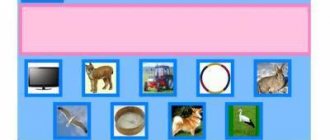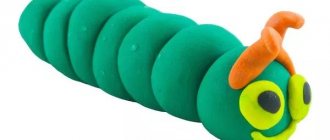Didactic games on the topic: “Autumn”
Description:
Didactic games on the topic: “Autumn”
Age: senior preschool age (5 - 6 years).
Head : Ekaterina Vladimirovna Moskovskaya.
The goal of the project : to clarify and consolidate knowledge on the topic “Autumn” in the senior group with speech impairments (OSD).
To develop the child’s speech, teach him to think independently, reason, and express his thoughts consistently and logically.
Tasks:
Educational:
- To consolidate children's knowledge about seasonal changes in nature.
- Continue teaching children to compose stories from pictures with sequentially developing events.
- Learn to form nouns in R. p.; in plural h.
Educational:
1. Continue to develop children’s speech activity.
2. Continue to develop coherent speech, expand and enrich your vocabulary on the topic.
3. Develop attention, memory, thinking.
4. Develop interest in knowledge about nature
Educational:
1. Cultivate a sustainable interest and interest in getting to know the nature of your native land;
2. Develop communication skills in communicating with adults and peers, encourage interest in joint gaming activities, and cultivate mutual understanding.
Implemented educational areas:
- Cognitive development.
- Social and communicative development.
- Speech development.
This project was created using MimioStudio software.
The project contains 21 pages. Each page is equipped with hyperlinks: old man - Lesovichok returns to the main page (game - walker) to continue the game.
Each page has instructions with tasks that slide out when you pull the red maple leaf. At the end of the game, the teacher clicks on the arrow on the right side of the sheet and follows the hyperlink to the last page - “portrait of Autumn.”
PAGE No. 1. Title page
PAGE No. 2. Contents of the project.
PAGE No. 3. Mnemonic table “Signs of autumn” - children, based on pictures, remember the signs of autumn. At the end of the conversation with the children, the old man - Lesovichok invites the children to play a game (follow the hyperlink to the game)
PAGE No. 4. Game - walker. The child clicks on the cube, names the number that comes out, takes a maple leaf with a stylus or hand and, starting with the number 1, takes steps forward. When stopping, the piece of paper remains behind the number, which means that there will be no more stopping here, then the child clicks on the number and uses a hyperlink to go to another page with the task. After completing the task, the child clicks on Lesovich and returns to the main page. The next child begins to count steps from the next number, not covered by a piece of paper, and steps over them along the way.
Goal: to arouse children's interest in activities.
PAGE No. 5. Sudoku. The child visually identifies and uses a stylus to move the animal to its place so that it is not repeated twice, either horizontally or vertically. If the child makes a mistake and clicks on the monkey, it will automatically be crossed out.
Goal: develop attentiveness and patience.
PAGE #6: Confusion. The child needs to look at pictures depicting the seasons, find mistakes and move them to their place, while explaining his actions.
Goal: to develop attentiveness, the ability to explain why the picture taken should be moved, and learn to justify your answer.
PAGE No. 7. Graphic dictation. The child selects a pencil from the tools, performs actions under the dictation of the teacher and guesses which animal it turns out to be (the answer is behind the curtain).
Goal: to develop fine motor skills and attentiveness.
PAGE No. 8. Find the number 2. Among the scattered leaves, you need to find those with the number 2 on them and use a Marker or Pencil (in the tools) to put a dot. When the child finds all the leaves on the field, he will see a large number 2; if desired, he can connect the dots.
Goal: To train children in the ability to find from a large number of pictures the one that is needed for the task. Develop mindfulness.
PAGE No. 9. Vegetable preparations. The child puts tomatoes and cucumbers into jars and counts them, answering the questions: how many? What is more, what is less?
Goal: strengthening the skills of ordinal counting, the ability to answer a question with a complete answer.
PAGE No. 10. Find a pair. The child repeats the names of colored autumn leaves, which tree they come from, chooses non-colored pictures and puts them into pairs.
Goal: development of concentration and logical thinking.
PAGE No. 11 . My fruits. The child selects a ball, clicks on it and says what fruits he sees, starting the sentence with the words “Mine...”.
Goal: learn to form nouns in the plural.
PAGE #12 : Find the shadow. The child takes a pencil, draws lines from the shadow to the animals in the picture, while naming the selected animals.
Goal: Development of visual attention.
PAGE No. 13. “How to grow tomatoes” The child looks at the pictures, moves them in the right order and composes a story based on the pictures with sequentially developing events.
Goal: continue to teach children to write a story using pictures.
PAGE No. 14. How does the color of a fur coat change with the arrival of winter? The teacher talks with the children about changes in the appearance of some animals before the onset of winter. Then the teacher moves the animals behind the tree and shows how the color of their fur coat changes.
Goal: development of visual-figurative thinking, attention, memory, ability to find cause-and-effect relationships.
PAGE No. 15. Vegetable salad. Having learned the task, the child selects from the proposed pictures those that correspond to the task and clicks on them. If the child is right, a tick appears; if not, a cross appears.
Goal: development of attention, logical thinking.
PAGE No. 16. Autumn landscape. The child can move the pictures onto and under the tree to create an autumn landscape. During the activities, the child tells what he is doing.
Goal: to develop the child’s coherent speech.
PAGE No. 17. Repeat the pattern. The child examines the pattern of autumn leaves and repeats it in the neighboring field, moving the colored leaves in the required quantity.
Goal: activation of cognitive activity through game elements.
PAGE No. 18. Find the fungus at the address. The child examines a field with mushrooms and a table with suggested tasks. Then it finds the desired mushroom and moves it to the table.
Goal: development of attention, logical thinking.
PAGE No. 19. Harvest apples. The teacher puts a number on the basket, and the child collects the same number of apples in the basket.
Goal: to consolidate counting skills in an entertaining way.
PAGE No. 20. Where do vegetables grow and where do fruits grow? The child moves pictures with vegetables and fruits into the proposed windows of the table, pronouncing and justifying his actions. The test area appears when you click on the triangle to the right of the table.
Goal: development of concentration and logical thinking.
PAGE No. 21. End of the project. " Portrait of Autumn."




